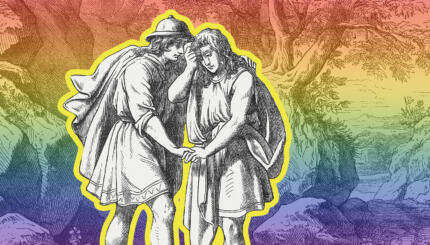Reform Judaism is often thought of as a “non-halakhic” or “post-halakhic” expression of the Jewish religion. But this is a misconception. Reform Jews do claim the freedom to create new forms of religious observance and to depart from traditional standards of practice when these seem to conflict with the basic ethical, aesthetic, and intellectual commitments that characterize the modern consciousness. At the same time, however, Reform Judaism is and has always been deeply involved with halakhah.
Reform Jews have never abandoned the literature and tradition of Jewish law. On the contrary: throughout the history of the Reform movement, its members have studied those texts as a way of working out their own best understandings of how to live as Jews. In so doing, they have created a halakhic literature all their own, a literature in which they talk and argue about their forms of religious observance in much the same way that Jews have always talked and argued about those subjects. Reform halakhic texts, in other words, cite the and other halakhic sources, debate their meaning, and interpret them from a contemporary perspective. We can divide these texts into four major categories.
1. Reform Responsa
Responsa (she’elot uteshuvot, literally “questions and answers”) are by far the largest genre of Reform halakhic writing. As is the case with traditional responsa, each Reform teshuvah (responsum) is an answer to a specific question concerning a matter of religious practice and observance.
 The earliest Reform responsa were produced in early 19th-century Europe, written by Reform rabbis who sought to provide a halakhic justification for the liturgical and ceremonial changes the movement introduced into synagogue practice. Since that time, Reform scholars have written halakhic responsa that deal with the entire range of ritual, ethical, and social issues of concern to Reform Jews.
The earliest Reform responsa were produced in early 19th-century Europe, written by Reform rabbis who sought to provide a halakhic justification for the liturgical and ceremonial changes the movement introduced into synagogue practice. Since that time, Reform scholars have written halakhic responsa that deal with the entire range of ritual, ethical, and social issues of concern to Reform Jews.

Help us keep Jewish knowledge accessible to millions of people around the world.
Your donation to My Jewish Learning fuels endless journeys of Jewish discovery. With your help, My Jewish Learning can continue to provide nonstop opportunities for learning, connection and growth.
In 1906 the Central Conference of American Rabbis (CCAR) established a Responsa Committee, which composes the movement’s “official” responsa. Like all Reform halakhic pronouncements, these responsa are advisory rather than obligatory in nature. No Reform Jew is required to practice his or her Judaism in a particular way solely because some rabbi or committee of rabbis says so. Whatever authority any responsum possesses lies in its ability to persuade its readers that this answer, as opposed to other plausible answers, is the best interpretation of Jewish tradition on this particular subject.
Each responsum, accordingly, offers a sustained argument in support of the decision that it has reached, inviting the reader to agree or to respond with arguments of his or her own.
Over the years, Reform responsa have been published in a variety of places, including issues of the CCAR’s annual Yearbook and its quarterly Journal. Twelve book-length collections of Reform responsa have been published; eight of these are the product of Rabbi Solomon B. Freehof, the leading halakhic figure in the history of North American Reform Judaism. All CCAR responsa issued since 1980 are available online (here) with a searchable database.
2. Guides to Religious Practice
Reform responsa are advisory and not obligatory, and the same can be said for the various guides to Jewish observance published under the auspices of the movement’s institutions. There are, in other words, no authoritative “codes” of Reform Jewish practice. At the same time, the Reform movement is hardly neutral or indifferent to the ways in which its adherents practice their Judaism.
The CCAR has produced a number of books and programmatic statements that set forth the position of the Conference on matters of religious observance. These include Gates of Mitzvah: A Guide to the Jewish Life Cycle (1979); Gates of the Seasons: A Guide to the Jewish Year; and Gates of Shabbat: A Guide for Observing Shabbat. Each of these volumes is deeply dependent upon the classical rabbinic and halakhic literature; these are halakhic texts par excellence.
In addition to specific details concerning practice, these books feature essays that discuss the theological rationale behind particular observances and explore the meaning of concepts such as “mitzvah” and “halakhah” in a Reform context.
The Conference also publishes literature intended specifically for professional rabbis but available to all readers. The Rabbi’s Manual is primarily a collection of liturgies for lifecycle ceremonies, but it also includes notes that discuss and explain the Conference’s stance regarding these ceremonies and on issues of personal status. The notes are drawn from the Bible, the Talmud, and the Codes, as well as from Conference resolutions and from the collected Reform responsa literature. Divre Gerut: Guidelines Concerning Proselytism, prepared by the CCAR Committee on conversion, discusses standards involved in working with prospective Jews-by-choice. Divre B’nei Mitzvah expounds the rules and standards governing the observance of Bar Mitzvah and Bat Mitzvah.
Alongside these “official” publications we find works by individual rabbis that summarize the state of Reform practice and explain it in light of the halakhic tradition. The classic example (in part because it reflects the state of observance during the “classical” period of American Reform Judaism) is Solomon B. Freehof’s Reform Jewish Practice and Its Rabbinic Background. More recently, my Jewish Living: A Guide to Contemporary Reform Practice offers a statement of the movement’s “official” positions and a detailed discussion of their halakhic background.
3. Liturgy
The siddur, the Jewish prayer book, is a halakhic as well as a liturgical text, because it reflects decisions made by Jewish communities and scholars concerning the proper wording (nusah) and order of prayer. As a way of underscoring the connection between Reform Jewish liturgy and its traditional Jewish roots, the CCAR has produced a volume of commentary for each of its major prayer books.
Gates of Understanding, Volume I contains historical, explanatory, and halakhic notes and articles covering Gates of Prayer, the movement’s daily, Sabbath, and festival siddur. Gates of Understanding, Volume II offers similar commentary for Gates of Understanding, the mahzor for the Days of Awe. The Passover haggadah published by the Conference similarly contains halakhic notes and instructions concerning the observance of the seder.
4. Theoretical Writings
Finally, there are writings that explore the theological and ideological basis of Reform or liberal halakhah, as well as ways in which Reform Judaism might draw guidance from the sources of Jewish law in various areas of ritual and ethical concern. Many of these are collected in volumes published by the Freehof Institute of Progressive Halakhah. To date, volumes have appeared dealing with such subjects as conversion, death and euthanasia, Israel-Diaspora relations, aging, gender issues, and the environment.


